為了避免NAS資料丟失或受損,建議您通過Cloud Backup對阿里雲Apsara File Storage NAS中的所有目錄及檔案進行備份。Cloud Backup支援配置靈活備份策略,將資料備份至雲端,您可以隨時查看和恢複資料。本文介紹如何使用Cloud Backup來備份檔案儲存NAS中的檔案。
前提條件
已開通阿里雲Cloud Backup服務。開通Cloud Backup不收取任何費用,使用Cloud Backup的阿里雲NAS備份功能會產生儲存容量費用等。更多資訊,請參見備份阿里雲NAS費用。
已建立阿里雲Apsara File Storage NAS。更多資訊,請參見建立通用型NAS檔案系統。
背景資訊
本文提及的NAS均指代阿里雲Apsara File Storage NAS。
阿里雲NAS備份支援NFS和SMB的檔案分享權限設定備份,不論已掛載或未掛載的NAS檔案系統,Cloud Backup都可以用同樣的操作流程實現備份。Cloud Backup在備份NAS時不進行檔案系統快照,而是基於高效的檔案系統掃描機制。
阿里雲NAS備份暫時不支援NAS SMB ACL特性,若您的NAS SMB檔案系統已開啟ACL特性,Cloud Backup無法備份許可權控制配置。NAS SMB ACL特性功能詳情,請參見Apsara File Storage NAS SMB ACL概述。
若您在備份SMB協議NAS時由於許可權問題導致備份失敗,請使用ECS檔案備份的方式進行備份。具體操作,請參見授予雲備份用戶端讀取SMB NAS檔案許可權和使用ECS檔案備份形式備份SMB NAS檔案。
您還可以使用ECS檔案備份方式來備份阿里雲NAS。更多資訊,請參見使用ECS檔案備份形式備份NFS NAS檔案。
注意事項
首次建立備份計劃或綁定備份策略,雲備份會自動建立服務關聯角色AliyunServiceRoleForHbrNasBackup,用於擷取訪問相關資源許可權。頁面會彈出授權對話方塊,根據提示授權角色。更多資訊,請參見雲備份服務關聯角色。
阿里雲NAS備份和恢複中,單個檔案的檔案名稱最大長度為248個位元組。若檔案名稱長度超過此限制,將導致該檔案備份和恢複失敗,任務部分完成。
在恢複阿里雲NAS檔案時,不支援恢複socket檔案、hardlink(永久連結)。
建立備份計劃周期性備份NAS檔案
建議所建立的每個NAS備份任務包含的檔案數量不超過5000萬,單個目錄下的檔案及子目錄數量之和不超過800萬。
建立備份計劃後,執行的第一次備份任務為全量備份,之後預設為增量備份。
請按如下步驟實現同地區備份NAS檔案系統。
在左側導覽列,選擇。
在頂部功能表列左上方,選擇所在地區。
在阿里云NAS頁簽,單擊创建备份计划。
在创建备份计划面板,按照如下說明填寫各項參數,然後單擊确定。
您首次試用可以享受免費備份計劃,計划到期日期為建立備份計劃之日起30天內。免費備份計劃無法使用備份策略,當前僅支援付費模式使用備份策略建立備份計劃。
免費試用計劃無法編輯備份路徑和備份周期,每個免費備份計劃使用各自獨立的備份庫,並且轉付費之後不可更換備份庫。如果您計劃將來所有資料備份到同一個備份庫,請不要使用免費試用計劃。
按如下說明填寫基礎設定中涉及的各項參數。
參數
說明
參數
說明
文件系统
從下拉式清單中選擇需要備份的檔案系統。
到期付费续用
免費備份計划到期後,是否執行到期付費續用。
單擊立即转为付费使用,啟用進階設定,並按如下說明填寫各項參數。
如果您選擇的地區支援備份策略,那麼您只能通過關聯備份原則設定備份計劃,雲備份會按照該備份策略周期性的備份阿里雲NAS。
您可以在控制台左側導覽列,單擊策略中心,查看已支援備份策略的地區。如何建立備份策略,請參見建立備份策略。
參數
說明
參數
說明
备份文件路径
輸入一個路徑,例如:
/nas/folder。备份文件规则
配置備份檔案規則。僅有滿足這些規則的檔案才會被備份。
包括所有文件:將備份所有檔案。
包含指定文件或排除指定文件,在輸入檔案清單框中手動填寫檔案清單,將按照規則備份指定的檔案。
备份策略
從下拉框選擇合適的備份策略。
Cloud Backup會按照您設定的備份策略,自動備份資料來源。備份策略主要包括備份庫加密方式、備份間隔、備份保留時間、異地複寫策略、備份自動歸檔以及備份點病毒檢測等操作,協助您靈活管理各資料來源資產。
如果預設備份策略無法滿足您的備份方案,您可以單擊管理策略,進入策略中心,建立或者修改備份策略。
關於備份策略中的參數解讀,請參見管理備份策略。
備份計劃建立完成後,備份計劃的狀態為计划中,Cloud Backup將按照指定的備份起始時間、備份執行間隔進行阿里雲NAS備份任務。
您可以在备份任务頁簽查看NAS備份任務進度,待指定的備份任務完成後,您可以將指定的備份源NAS中的備份資料恢複至本NAS或其他指定的NAS檔案系統。
備份成功
當達到備份執行時間時,Cloud Backup就會啟動執行備份任務。當備份任務狀態為成功時,表示當天備份完成。
您可以在备份计划頁簽,找到目標NAS,在操作列單擊备份历史,可以在备份历史中看到每次備份記錄。後續,您可以根據這些歷史備份進行檔案恢複。更多操作,請參見建立同地區單個NAS檔案系統恢複任務。

瀏覽和下載備份檔案
瀏覽備份檔案
通過浏览功能,您可以瀏覽已經備份的檔案。如果瀏覽的備份點進行過病毒檢測,雲備份會對被病毒感染的檔案進行標記。
在备份计划頁簽,找到目標NAS,在操作列單擊备份历史。
在备份历史中,找到對應時間點的備份點,單擊浏览。
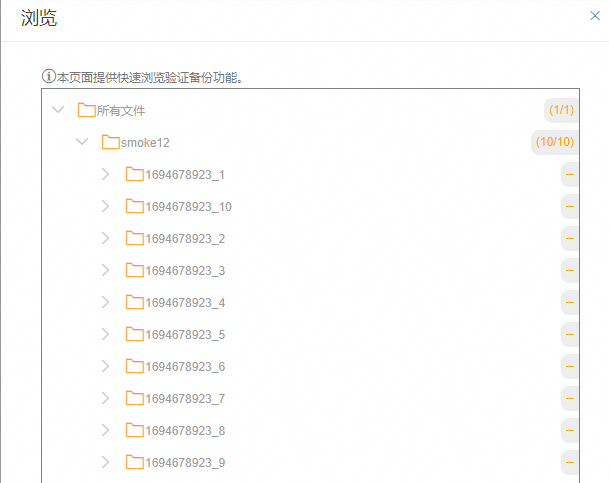
下載備份檔案
不支援直接下載已備份檔案。您可以通過恢複到一個指定的臨時NAS路徑(恢複不收費),然後在NAS側間接實現檔案下載。
病毒檢測
為了避免攜帶病毒的檔案被恢複到生產環境中,Cloud Backup服務提供备份点病毒检测功能,來協助您選取乾淨安全的備份點以便以後進行資料恢複,您可以單擊病毒检测對檔案進行病毒檢查。更多資訊,請參見備份點病毒檢測。
錯誤處理
當備份計劃或備份任務状态異常時,您可以參考以下建議進行處理。
備份任務的状态:失败(路径无法访问。)
備份計劃中备份文件路径指定的路徑不存在。請修改備份計劃路徑,確認組成的網路路徑是存在的。在备份计划頁簽,目標檔案系統的操作列,選擇更多>编辑计划修改備份檔案路徑。

備份任務的状态:失败(文件系统不存在)
該阿里雲NAS已經被刪除。
如果刪除阿里雲NAS屬於正常操作,請無需關注備份任務狀態。為避免產生額外備份儲存容量費用,建議您在左側導覽列,單擊存储库管理,找到對應存放庫進行刪除。
如果刪除阿里雲NAS屬於誤操作,您想恢複該阿里雲NAS。請在對應地區建立一個阿里雲NAS,將該阿里雲NAS作為恢複目的地,即可完成阿里雲NAS檔案恢複。具體操作,請參見建立同地區單個NAS檔案系統恢複任務。
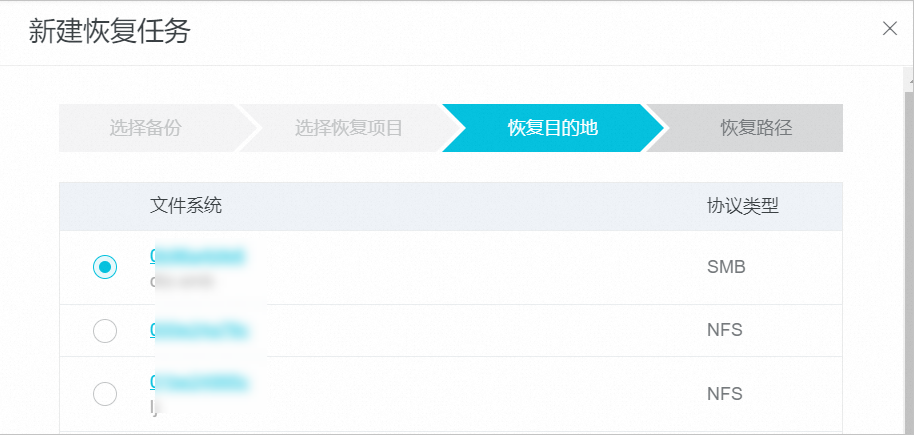
備份計劃的状态:暂停
該備份計劃已經被暫停。暫停後,Cloud Backup不再繼續進行阿里雲NAS備份保護。建議您儘快啟用備份計劃。
建立同地區單個NAS檔案系統恢複任務
請按如下步驟實現同地區恢複單個NAS檔案系統。
在恢复任务頁簽,單擊创建恢复任务。
在新建恢复任务面板,配置如下資訊。
選擇備份,然後單擊下一步。
參數
說明
參數
說明
备份库
選擇待恢複的NAS所在的備份庫。
已备份的NAS
從已經備份的NAS裡面選一個作為要恢複的源NAS。
待恢复的备份
在待恢複備份列表中,選擇待恢複的備份。
在选择恢复项目頁簽,選擇恢复项目,然後單擊下一步。
參數
說明
參數
說明
恢复项目
選擇待恢複的專案。
包含所有檔案:將恢複所選源NAS執行個體下的所有檔案。
包含下列檔案:勾選需要恢複的檔案夾或檔案。您也可以在输入文件列表框中手動填寫檔案清單,將按照規則恢複所選NAS執行個體下指定的檔案。
排除下列檔案:勾選不需要恢複的檔案夾或檔案。您也可以在输入文件列表框中手動填寫不需要恢複的檔案清單,其餘路徑的檔案將被全部恢複。
在檔案清單每行填寫一個路徑,且每一行只能以源備份路徑最後一個檔案夾開頭。例如備份路徑為/test/data,要恢複data檔案夾下file.txt和abc,請按如下格式填寫路徑。
/data/file.txt /data/abc在恢复目的地頁簽,選擇該地區下的需要恢複的文件系统,單擊下一步。
在恢复路径頁簽,配置復原路徑,然後單擊創建。
參數
說明
參數
說明
恢复路径类型
選擇復原路徑類型。
指定路徑:配置新路徑,並恢複到這個目錄。
原路徑:恢複到備份時的原路徑。
恢复路径
僅當恢复路径类型參數取值為指定路徑時,該參數需要配置。表示恢複的路徑。例如/nas/abc。
恢复路径存在同名文件时
跳過此檔案。
覆蓋復原路徑同名檔案。
比較更新時間,保留最新版本。
恢複前進行病毒檢測
開啟後,雲備份在恢複前對所有待恢複的檔案進行病毒檢測。詳情請參考控制台。更多資訊,請參見備份點病毒檢測。
恢複項包含已檢測到的病毒時
不恢複病毒檔案(可在病毒檢測頁面尋找安全版本)
我已知曉風險,仍然恢複所有選中項
恢複任務建立後,可以在恢复任务頁簽的状态欄查看恢複任務進度。
為備份庫建立異地鏡像備份(跨地區備份)
備份庫是雲備份的雲上儲存倉庫,用於儲存備份的資料。您可以根據備份容災的需要,為一個倉庫建立異地鏡像備份庫,用來備份源備份庫的所有備份資料。
請按如下步驟實現跨地區備份:
單擊概览,選擇有備份庫的地區,例如華東1(杭州),然後單擊對應備份庫右上方的跨地域备份。

在建立鏡像備份庫面板,配置以下參數,然後單擊創建。
每個備份庫只可建立一個鏡像倉庫。
鏡像備份庫只能用於跨地區複製,無法在鏡像備份庫中建立備份計劃。源備份庫的歷史存量資料將會在鏡像備份庫建立成功後的90分鐘之後開始同步。
鏡像備份庫中包含建立鏡像時源備份庫的所有備份資料。
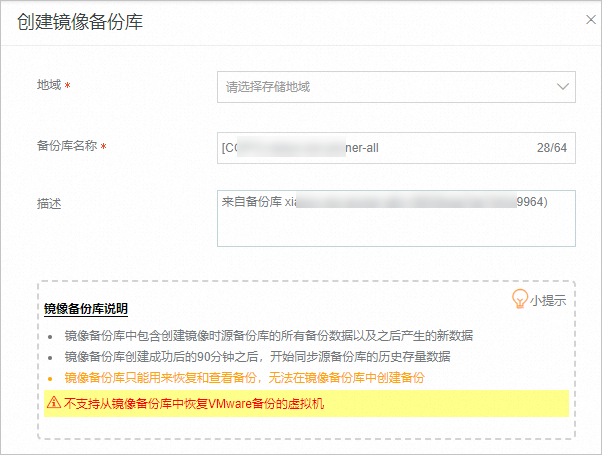
參數
說明
參數
說明
地域
選擇儲存鏡像備份庫的地區。
备份库名称
指定備份庫的名稱。
描述
鏡像備份庫的描述資訊。
鏡像備份庫建立完成一段時間後,您可以查看資料同步進度。待資料同步完成後,即可開始跨地區恢複NAS檔案系統。
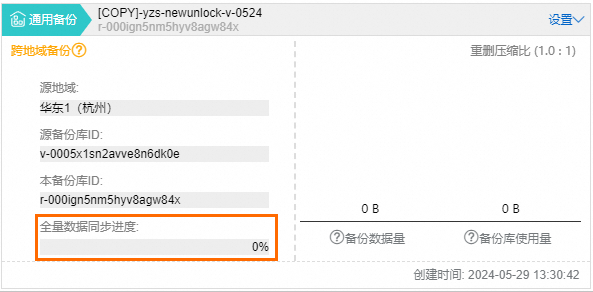
使用異地鏡像備份庫跨地區恢複NAS
備份庫是雲備份的雲上儲存倉庫,用於儲存備份的資料。您可以根據備份容災的需要,使用異地鏡像備份庫實現跨地區恢複單個NAS檔案系統。
選擇鏡像備份庫所在的地區,在左側導覽列選擇,單擊阿里云NAS。
單擊恢复任务頁簽,然後單擊创建恢复任务。
在选择备份頁簽,按要求填寫各項參數。
需選擇已建立的鏡像備份庫,且鏡像備份庫名稱帶[COPY]字樣。其他各項參數填寫要求與备份库建立同地區單個NAS檔案系統恢複任務類似。
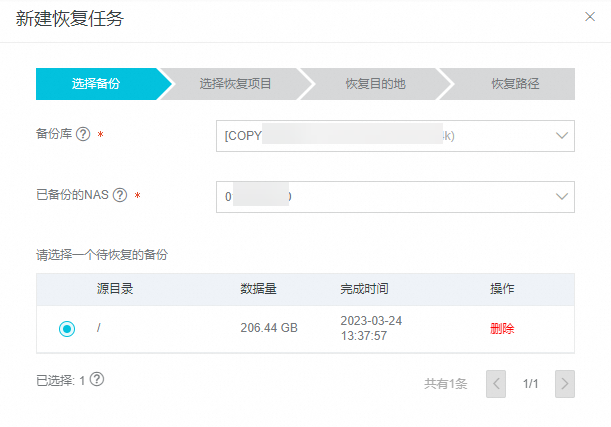
更多操作
單擊NAS備份頁簽右上方的管理备份挂载点,您可以執行如下操作:
查看所選地區下的所有檔案系統,單擊某一檔案系統連結,可以查看當前NAS檔案系統的詳情,例如協議類型、掛載點數量等。
移除备份挂载点:建立備份計劃時,Cloud Backup服務會在NAS檔案系統中自動建立一個掛載點。由於此掛載點由阿里雲內部服務建立,無法直接刪除。因此,當需要刪除NAS檔案系統時,請單擊管理備份掛載點頁面下某個NAS檔案系統右側對應的移除备份挂载点。刪除NAS備份掛載點會導致備份失敗,請確保所有備份計劃都已刪除,且沒有正在啟動並執行備份或恢複任務。
備份計劃建立完成後,將按照指定的備份起始時間、備份執行間隔進行NAS備份任務。您還可以在备份计划頁簽的操作列,執行以下操作:
操作 | 說明 |
操作 | 說明 |
备份历史 | 您可以查看該檔案系統最近3個月或者所有的備份歷史。 |
開始執行備份計劃。 | |
暫停執行中的備份計劃。如需再次啟動備份計劃,選擇。 | |
修改已建立的備份計劃。 | |
刪除執行中的備份計劃。備份計劃刪除後,該備份計劃不會繼續執行,但仍保留已備份的資料。 | |
設定備份警示的方式。
|





















